Description of a New Species of Mountain Midges (Diptera, Deuterophlebiidae) from Xinjiang, China †
Simple Summary
Abstract
1. Introduction
2. Materials and Methods
3. Results
3.1. Morphological Description of the Species
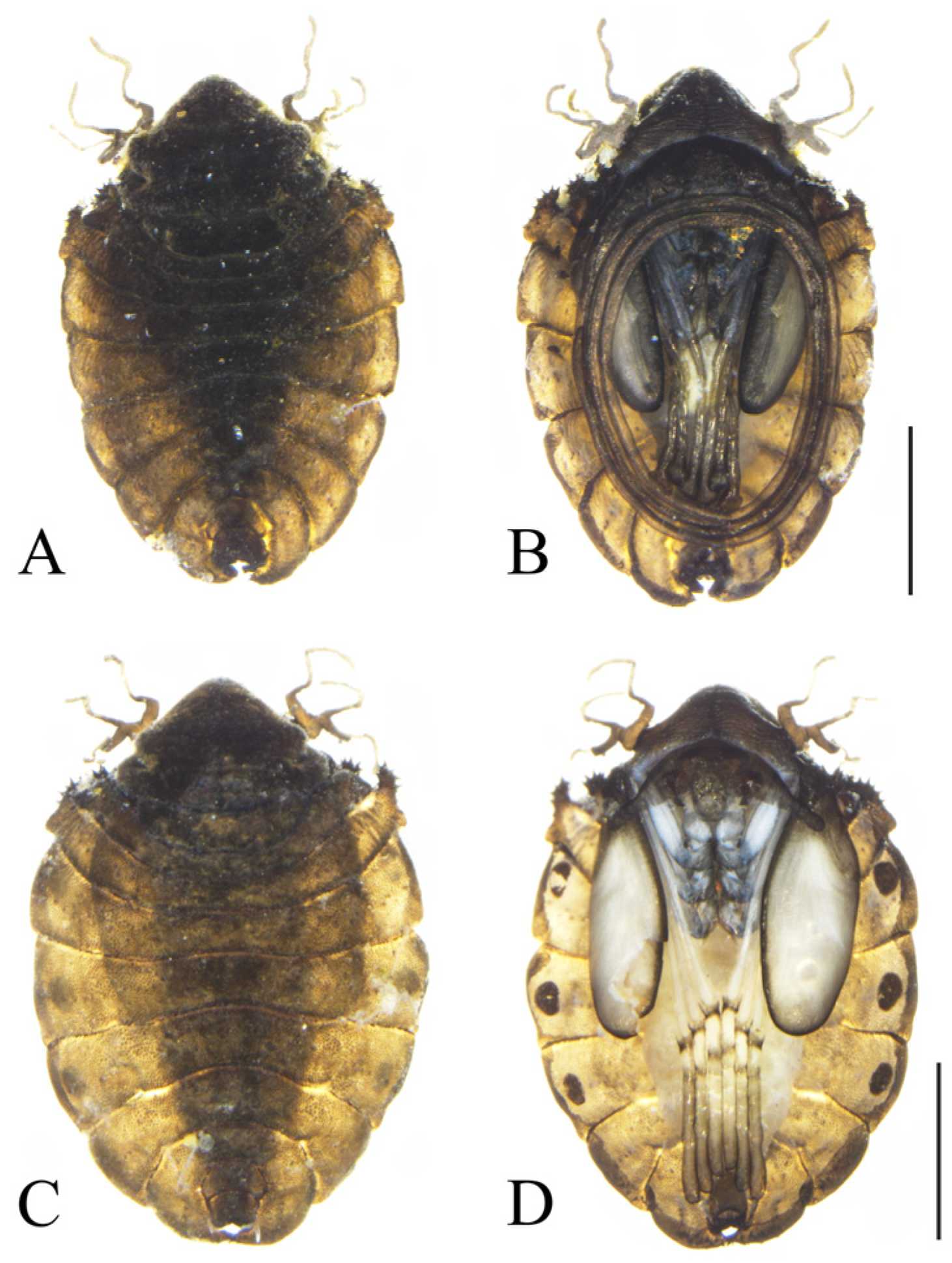
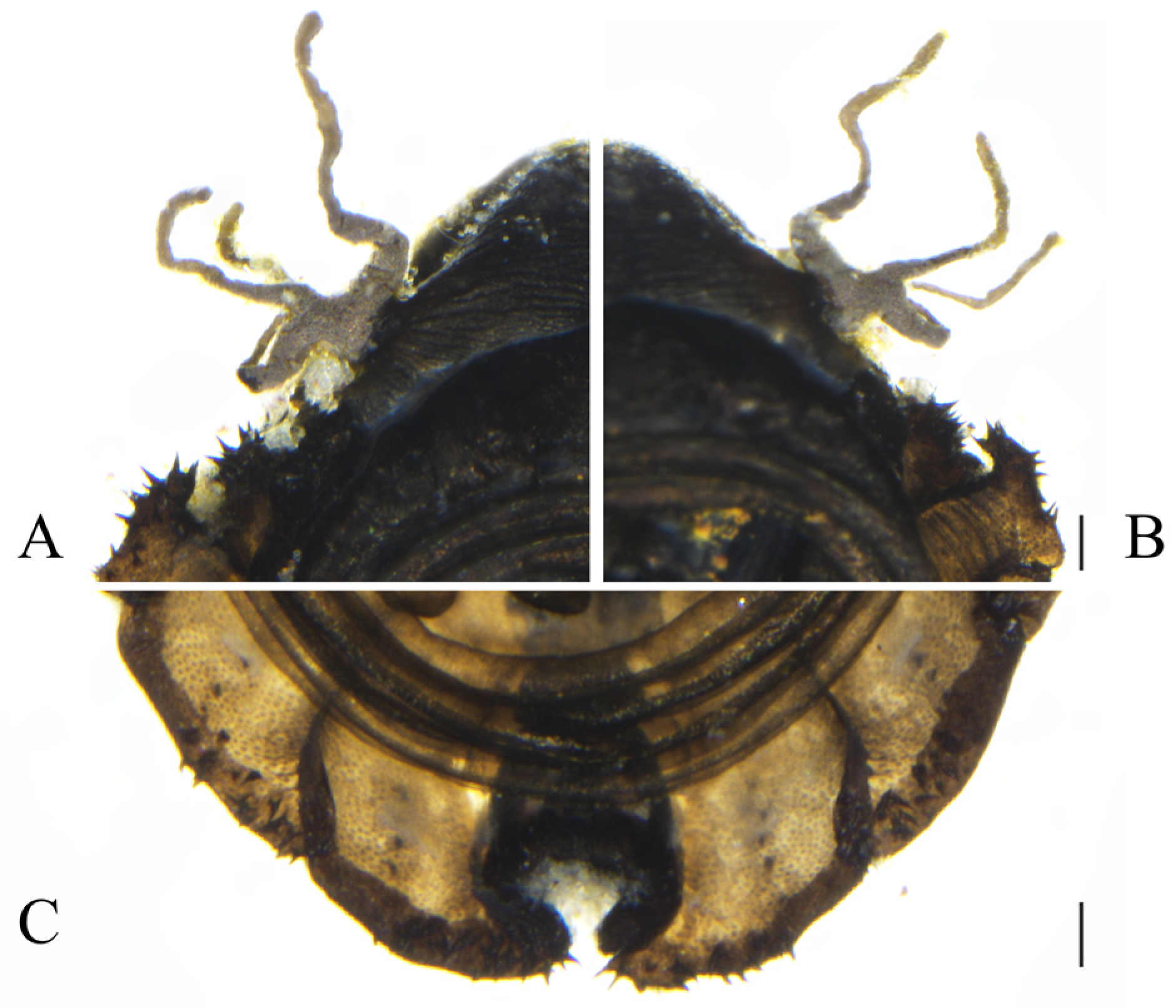
3.2. Molecular Study
3.3. Biological Notes

4. Discussion
5. Keys to Asian Deuterophlebia Pupae
- 1.
- Mesothorax with lateral outgrowths........................................................................D. alata
- –
- Mesothorax without lateral outgrowths (Figure 2)...............................................................................................................................................2
- 2.
- Abdominal tergites VI–VII with posterolateral projections........................D. pseudopoda
- –
- Abdominal tergites VI–VII without posterolateral projections (Figure 3)...............................................................................................................................................3
- 3.
- Mesothorax without spines on anterolateral margin (Figure 2)...............................................................................................................................................4
- –
- Mesothorax with spines on anterolateral margin............................................................................................................................................6
- 4.
- have transverse chitin bands and a macrogranulation on the tergite...........D. nipponica
- –
- without transverse chitin bands and a macrogranulation on the tergite.......................................................................................................................................5
- 5.
- –
- Head backboard not highly elevated, the second abdominal segment does not protrude outward, shorter than or equal in length to the third thoracic segment........................................................................................................................D. mirabilis
- 6.
- Mesothorax with one pair of spines on anterolateral margin............................................................................................................................................7
- –
- Mesothorax with two pairs of spines on anterolateral margin............................................................................................................................................8
- 7.
- Abdominal tergites with dark bands................................................................D. bicarinate
- –
- Abdominal tergites without dark bands..................................D. sajanica, D. yunnanensis
- 8.
- Abdominal tergites with dark bands................................................................D. wuyiensis
- –
- Abdominal tergites without dark bands.......................................................................................................................................9
- 9.
- Abdominal tergites with a pair of large dark dots..........................................D. acutirhina
- –
- Abdominal tergites without obvious larger dark dots.........................................................................................................................................10
- 10.
- Mesothoracic spines expanded basally.........................................................D. pachychaeta
- –
- Mesothoracic spines not expanded basally........................................................................................................................................11
- 11.
- Gills with elongated posterior filaments.............................................................D. sinensis
- –
- Gills with indistinct posterior filaments........................................................D. tyosenensis
Author Contributions
Funding
Data Availability Statement
Acknowledgments
Conflicts of Interest
Abbreviation
| D. | Deuterophlebia |
References
- Krzemińska, E.; Soszyńska, A.; Kania-Kłosok, I.; Skibińska, K.; Kopeć, K.; van de Kamp, T.; Zhang, Q.; Krzemiński, W. First fossil mountain midges (Diptera, Deuterophlebiidae) and their evolutionary and ecological implication. Sci. Rep. 2024, 14, 24864. [Google Scholar] [CrossRef]
- Courtney, G.W. Morphology, Systematics and Ecology of Mountain Midges (Diptera: Deuterophlebiidae). Ph.D. Thesis, University of Alberta, Edmonton, AB, Canada, 10 August 1989. [Google Scholar]
- Courtney, G.W. Life history patterns of Nearctic mountain midges (Diptera: Deuterophlebiidae). J. N. Am. Benthol. Soc. 1991, 10, 177–197. [Google Scholar] [CrossRef]
- Zheng, X.; Chen, Z.; Mu, P.; Ma, Z.; Zhou, C. Descriptions and Barcoding of Five New Chinese Deuterophlebia Species Revealing This Genus in Both Holarctic and Oriental Realms (Diptera: Deuterophlebiidae). Insects 2022, 13, 593. [Google Scholar] [CrossRef] [PubMed]
- Courtney, G.W. Revision of Palaearctic mountain midges (Diptera: Deuterophlebiidae), with phylogenetic and biogeographic analyses of world species. Syst. Entomol. 1994, 19, 1–24. [Google Scholar] [CrossRef]
- Edwards, F.W. XLVI.—Deuterophlebia mirabilis, gen. et sp. n., a remarkable Dipterous insect from Kashmir. Ann. Mag. Nat. Hist. Zool. Bot. Geol. 1922, 9, 379–387. [Google Scholar] [CrossRef]
- Jedlicka, L.; Halgos, J. Deuterophlebia sajanica sp.n., a new species of mountain midges from Mongolia (Diptera: Deuterophlebiidae). Biologia 1981, 36, 973–981. [Google Scholar]
- Sofi, M.S.; Bhat, S.U.; Subramanian, K.A.; Sabha, I.; Rashid, I.; Kuniyal, J.C. Deuterophlebia Edwards, 1922 (Diptera: Deuterophlebiidae) an Enigmatic Primitive Diptera (Insecta) from Kashmir Himalaya. Halteres 2020, 11, 94–97. [Google Scholar] [CrossRef]
- Pennak, R.W. Description of the imago of the mountain midge Deuterophlebia coloradensis Pennak (Diptera, Deuterophlebiidae). Am. Mus. Novit. 1951, 1534, 1–11. [Google Scholar]
- Kennedy, H.D. Biology and life history of a new species of mountain midge, Deuterophlebia nielsoni, from Eastern California (Diptera: Deuterophlebiidae). Trans. Am. Microsc. Soc. 1958, 77, 201. [Google Scholar] [CrossRef]
- Kennedy, H.D. Deuterophlebia invoensis, a new species of mountain midge from the alpine zone of the Sierra Nevada Range, California (Diptera: Deuterophlebiidae). Trans. Am. Microsc. Soc. 1960, 79, 191–210. [Google Scholar] [CrossRef]
- Courtney, G.W. Revision of Nearctic mountain midges (Diptera: Deuterophlebiidae). J. Nat. Hist. 1990, 24, 81–118. [Google Scholar] [CrossRef]
- Zheng, X.; Zhou, C. Two new species of Deuterophlebia Edwards, 1922 from Southwestern China (Diptera, Deuterophlebiidae). Dtsch. Entomol. Z. 2023, 70, 387–401. [Google Scholar] [CrossRef]
- Folmer, O.; Black, M.; Hoeh, W.; Lutz, R.; Vrijenhoek, R. DNA Primers for amplification of mitochondrial cytochrome C oxidase subunit I from diverse metazoan invertebrates. Mol. Mar. Biol. Biotech. 1994, 3, 294–299. [Google Scholar]
- Tamura, K.; Stecher, G.; Kumar, S. MEGA11: Molecular evolutionary genetics analysis version 11. Mol. Biol. Evol. 2021, 38, 3022–3027. [Google Scholar] [CrossRef] [PubMed]
- Pulikovsky, N. Metamorphosis of Deuterophlebia Sp. (Diptera, Deuterophlebiidae Edw.). Trans. R. Entomol. Soc. Lond. 1924, 72, 45–62. [Google Scholar] [CrossRef]
- Kitakami, S. The Deuterophlebiidae of Japan. Annot. Zool. Jpn. 1938, 17, 487–507. [Google Scholar]
- Yu, H.; Shi, M.-R.; Xu, J.; Chen, P.; Liu, J.-H. Mating-Induced Trade-Offs upon Egg Production versus Fertilization and Offspring’s Survival in a Sawfly with Facultative Parthenogenesis. Insects 2021, 12, 693. [Google Scholar] [CrossRef]
- Brodsky, K. Zur Kenntnis der Wirbellosenfauna der Bergströme Mittelasien. II. Deuterophlebia mirabilis EDW. Z. Morphol. Ökol. Tiere 1930, 18, 289–321. [Google Scholar] [CrossRef]
- Schneeberg, K.; Courtney, G.W.; Beutel, R.G. Adult head structures of Deuterophlebiidae (Insecta), a highly derived “Ancestral” dipteran lineage. Arthropod Struct. Dev. 2011, 40, 93–104. [Google Scholar] [CrossRef]
- Courtney, G.W. Phylogenetic analysis of the Blephariceromorpha, with special reference to mountain midges (Diptera: Deuterophlebiidae). Syst. Entomol. 1991, 16, 137–172. [Google Scholar] [CrossRef]
- Zhang, X.; Yang, D.; Kang, Z. Net-Winged Midge Genus Blepharicera Macquart (Diptera: Blephariceridae) in China: The First DNA Barcode Database with Descriptions of Four New Species and Notes on Distribution. Insects 2022, 13, 794. [Google Scholar] [CrossRef]
- Wang, Q.; Zhang, M.-L.; Yin, L.-K. Phylogeographic Structure of a Tethyan Relict Capparis Spinosa (Capparaceae) Traces Pleistocene Geologic and Climatic Changes in the Western Himalayas, Tianshan Mountains, and Adjacent Desert Regions. Biomed Res. Int. 2016, 2016, 1–13. [Google Scholar] [CrossRef]
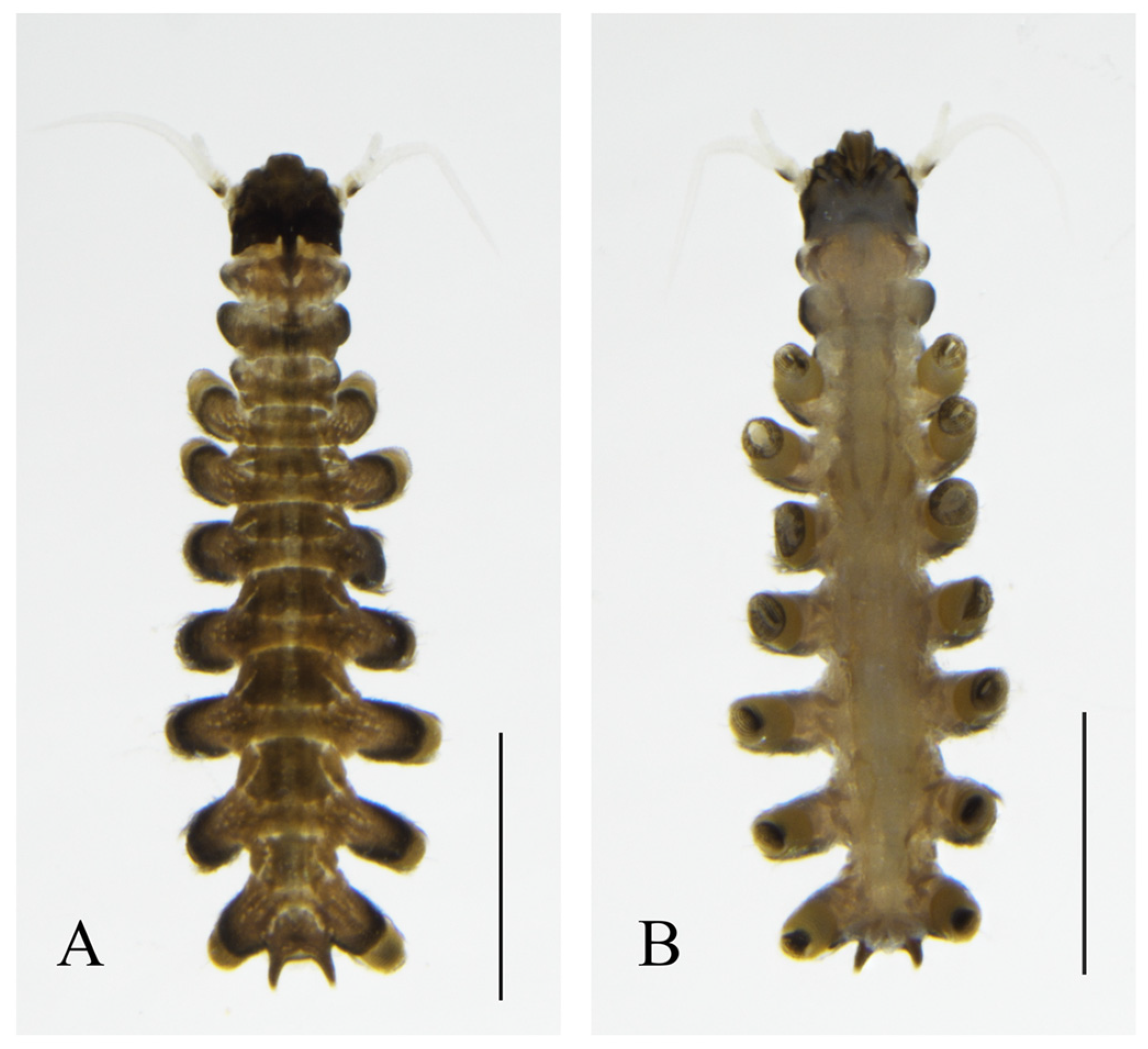
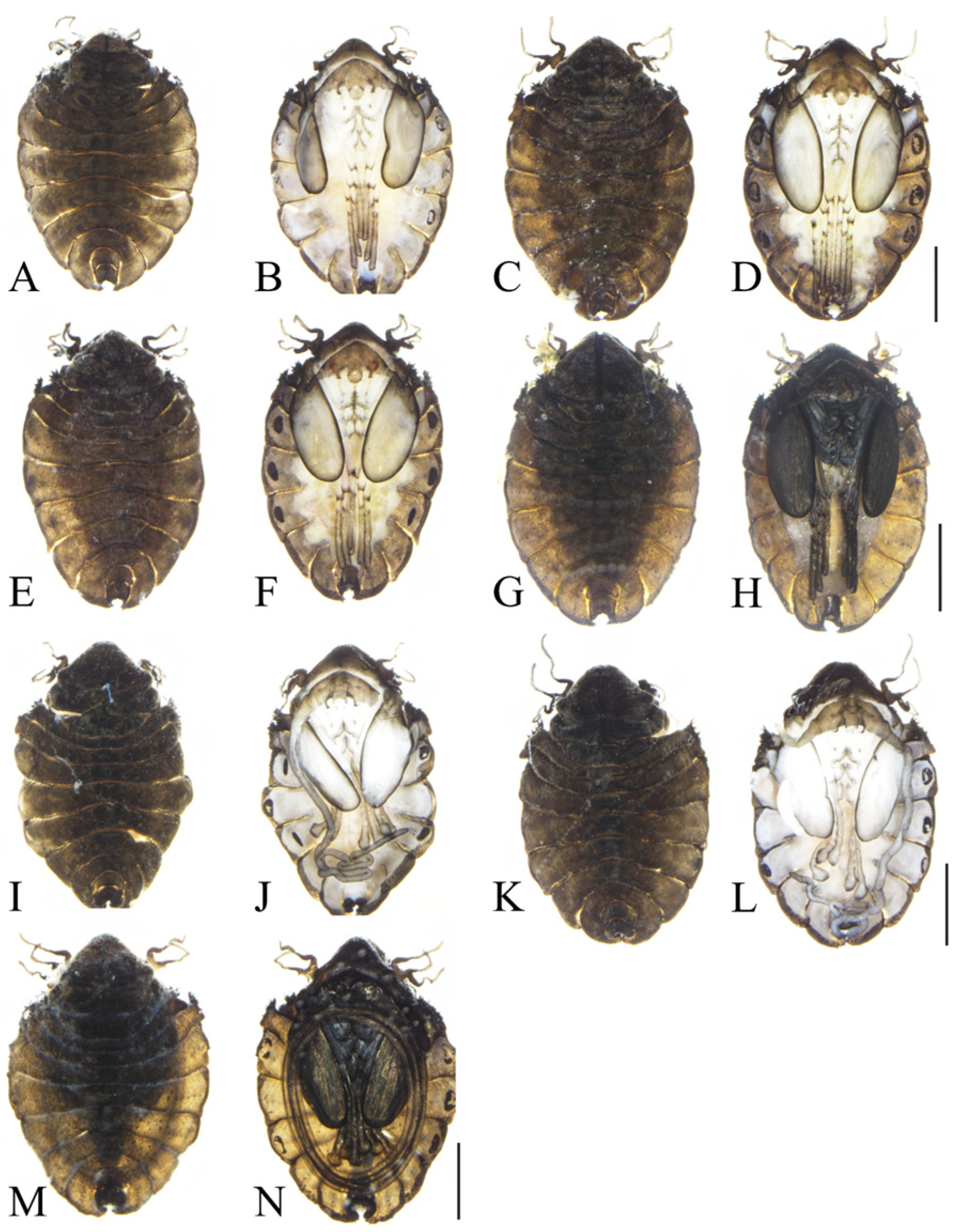
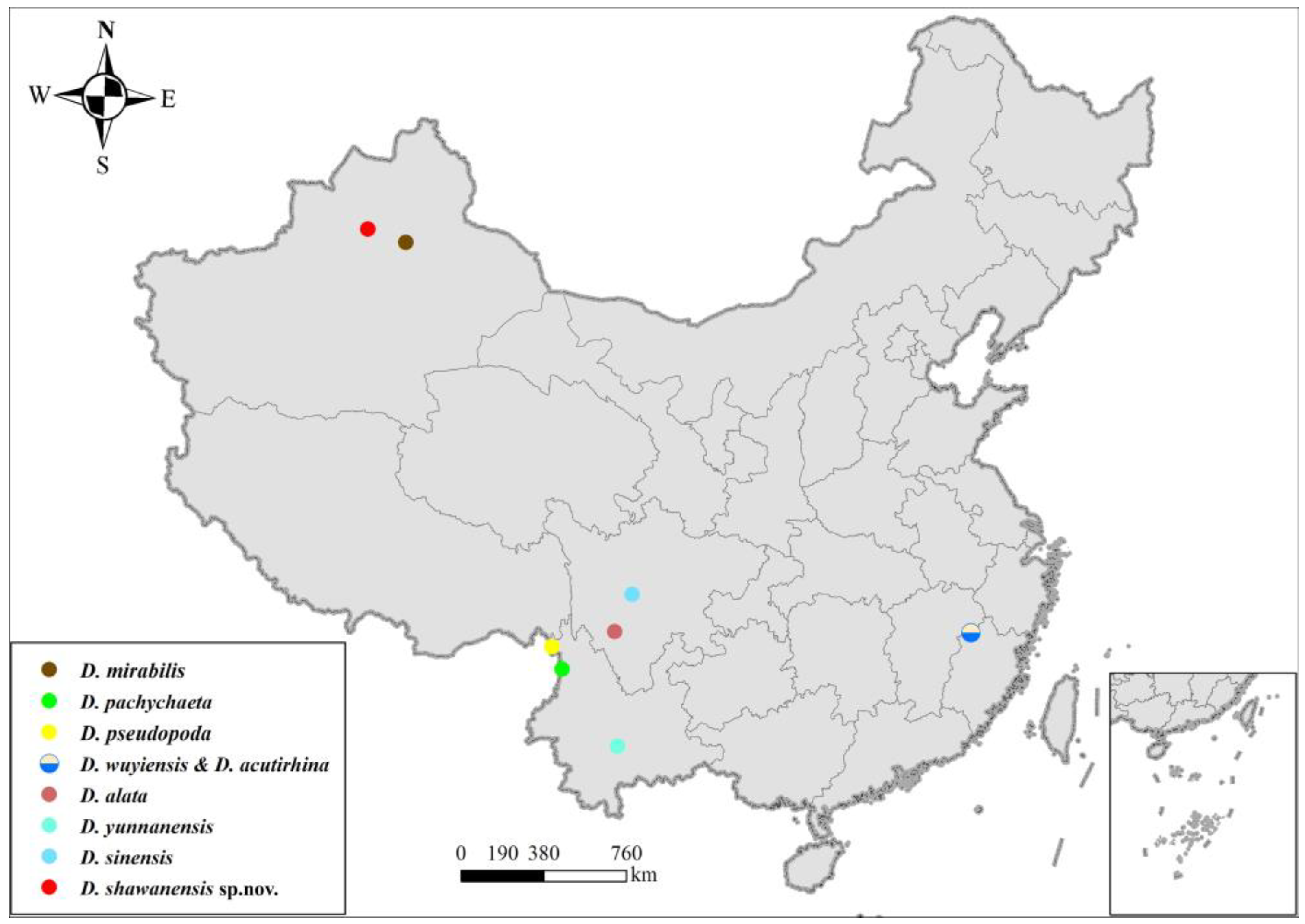
| Species | Specimen Code | Life Stage | Sample Sites | GenBank Accession Number |
|---|---|---|---|---|
| D. shawanensis sp. nov. | XJ1 | Female pupa | 43°59′0.99″ N, 85°13′43.79″ E 1594.5 m | PX091279 |
| XJ2 | Male pupa | PX091280 |
| Values | D. shawanensis sp. nov. | D. pseudopoda | D. pachychaeta | D. alatus | D. wuyiensis | D. acutirhina | D. sinensis |
|---|---|---|---|---|---|---|---|
| D. pseudopoda | 0.134 | ||||||
| D. pachychaeta | 0.125 | 0.119 | |||||
| D. alatus | 0.143 | 0.138 | 0.143 | ||||
| D. wuyiensis | 0.143 | 0.139 | 0.150 | 0.140 | |||
| D. acutirhina | 0.134 | 0.142 | 0.146 | 0.134 | 0.137 | ||
| D. sinensis | 0.113 | 0.117 | 0.108 | 0.138 | 0.155 | 0.156 | |
| D. yunnanensis | 0.122 | 0.116 | 0.086 | 0.146 | 0.149 | 0.150 | 0.149 |
| Altitude (m) | Wide (m) | Deep (m) | T (°C) | COD (mg/L) | PH |
|---|---|---|---|---|---|
| 1594.5 | 1.5 | 1.2 | 10 | 11 | 8.8 |
Disclaimer/Publisher’s Note: The statements, opinions and data contained in all publications are solely those of the individual author(s) and contributor(s) and not of MDPI and/or the editor(s). MDPI and/or the editor(s) disclaim responsibility for any injury to people or property resulting from any ideas, methods, instructions or products referred to in the content. |
© 2025 by the authors. Licensee MDPI, Basel, Switzerland. This article is an open access article distributed under the terms and conditions of the Creative Commons Attribution (CC BY) license (https://creativecommons.org/licenses/by/4.0/).
Share and Cite
Wang, X.; Gao, M.; Li, X.; Han, R.; Feng, J.; Guo, W. Description of a New Species of Mountain Midges (Diptera, Deuterophlebiidae) from Xinjiang, China. Insects 2025, 16, 965. https://doi.org/10.3390/insects16090965
Wang X, Gao M, Li X, Han R, Feng J, Guo W. Description of a New Species of Mountain Midges (Diptera, Deuterophlebiidae) from Xinjiang, China. Insects. 2025; 16(9):965. https://doi.org/10.3390/insects16090965
Chicago/Turabian StyleWang, Xin, Minghui Gao, Xinyang Li, Rui Han, Jiayang Feng, and Wei Guo. 2025. "Description of a New Species of Mountain Midges (Diptera, Deuterophlebiidae) from Xinjiang, China" Insects 16, no. 9: 965. https://doi.org/10.3390/insects16090965
APA StyleWang, X., Gao, M., Li, X., Han, R., Feng, J., & Guo, W. (2025). Description of a New Species of Mountain Midges (Diptera, Deuterophlebiidae) from Xinjiang, China. Insects, 16(9), 965. https://doi.org/10.3390/insects16090965






